Mindi Ruan
Video-based Analysis Reveals Atypical Social Gaze in People with Autism Spectrum Disorder
Sep 01, 2024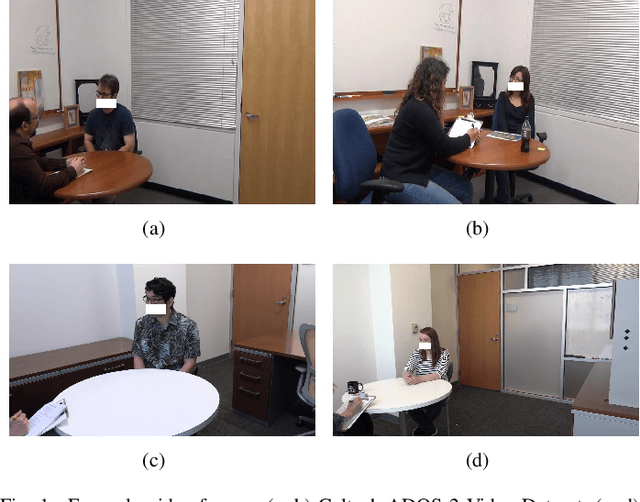
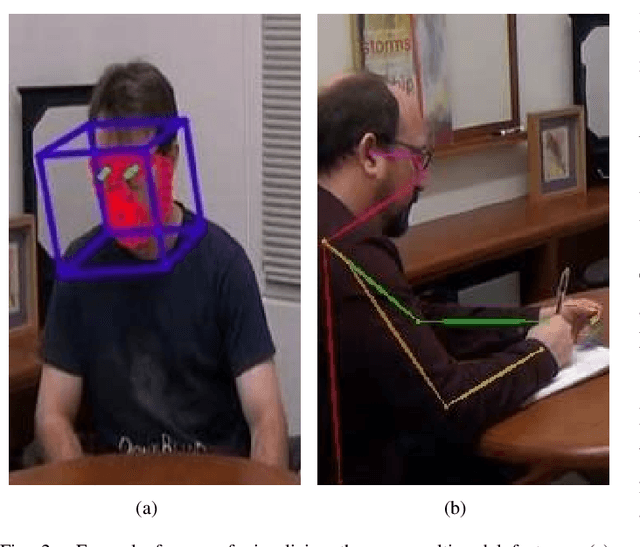
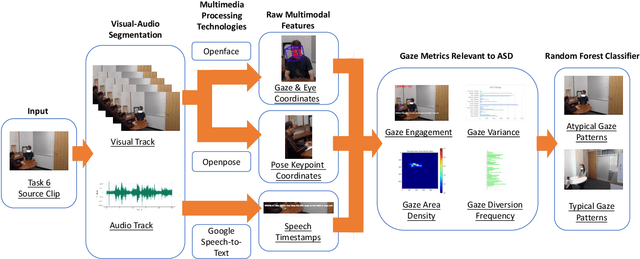

Abstract:In this study, we present a quantitative and comprehensive analysis of social gaze in people with autism spectrum disorder (ASD). Diverging from traditional first-person camera perspectives based on eye-tracking technologies, this study utilizes a third-person perspective database from the Autism Diagnostic Observation Schedule, 2nd Edition (ADOS-2) interview videos, encompassing ASD participants and neurotypical individuals as a reference group. Employing computational models, we extracted and processed gaze-related features from the videos of both participants and examiners. The experimental samples were divided into three groups based on the presence of social gaze abnormalities and ASD diagnosis. This study quantitatively analyzed four gaze features: gaze engagement, gaze variance, gaze density map, and gaze diversion frequency. Furthermore, we developed a classifier trained on these features to identify gaze abnormalities in ASD participants. Together, we demonstrated the effectiveness of analyzing social gaze in people with ASD in naturalistic settings, showcasing the potential of third-person video perspectives in enhancing ASD diagnosis through gaze analysis.
Exploring Speech Pattern Disorders in Autism using Machine Learning
May 03, 2024
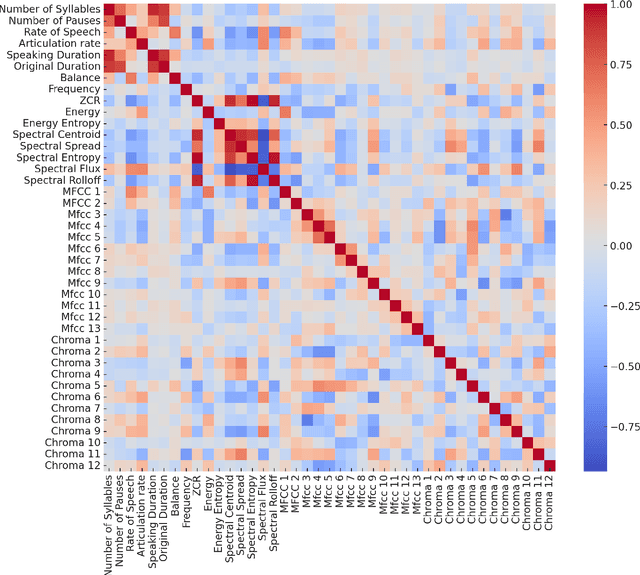
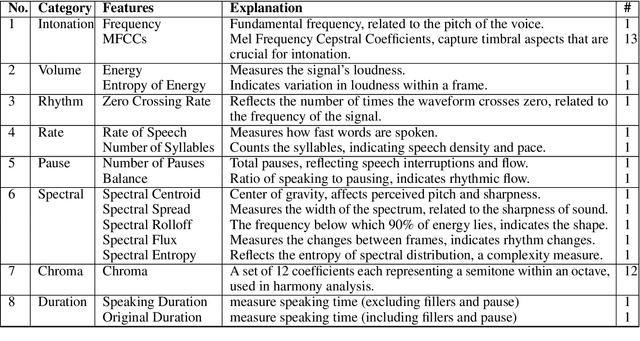
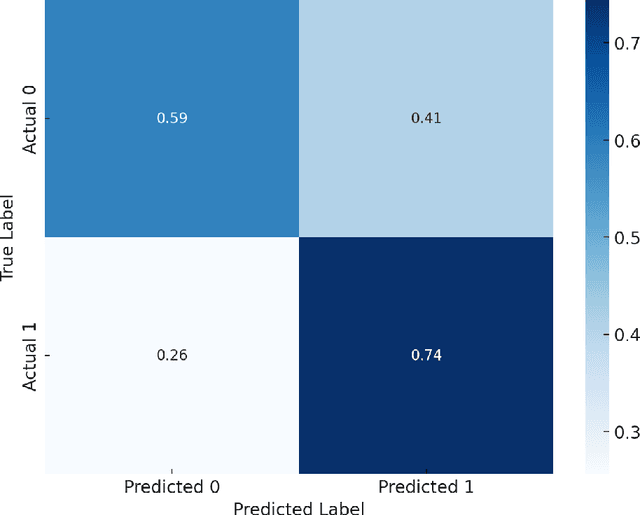
Abstract:Diagnosing autism spectrum disorder (ASD) by identifying abnormal speech patterns from examiner-patient dialogues presents significant challenges due to the subtle and diverse manifestations of speech-related symptoms in affected individuals. This study presents a comprehensive approach to identify distinctive speech patterns through the analysis of examiner-patient dialogues. Utilizing a dataset of recorded dialogues, we extracted 40 speech-related features, categorized into frequency, zero-crossing rate, energy, spectral characteristics, Mel Frequency Cepstral Coefficients (MFCCs), and balance. These features encompass various aspects of speech such as intonation, volume, rhythm, and speech rate, reflecting the complex nature of communicative behaviors in ASD. We employed machine learning for both classification and regression tasks to analyze these speech features. The classification model aimed to differentiate between ASD and non-ASD cases, achieving an accuracy of 87.75%. Regression models were developed to predict speech pattern related variables and a composite score from all variables, facilitating a deeper understanding of the speech dynamics associated with ASD. The effectiveness of machine learning in interpreting intricate speech patterns and the high classification accuracy underscore the potential of computational methods in supporting the diagnostic processes for ASD. This approach not only aids in early detection but also contributes to personalized treatment planning by providing insights into the speech and communication profiles of individuals with ASD.
Exploiting ChatGPT for Diagnosing Autism-Associated Language Disorders and Identifying Distinct Features
May 03, 2024
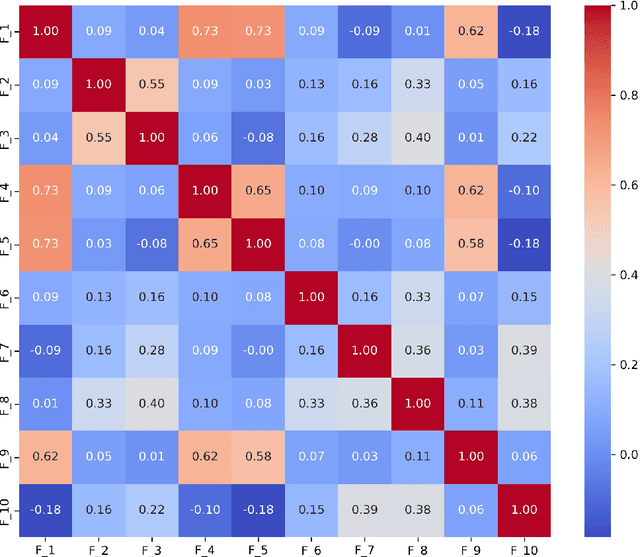

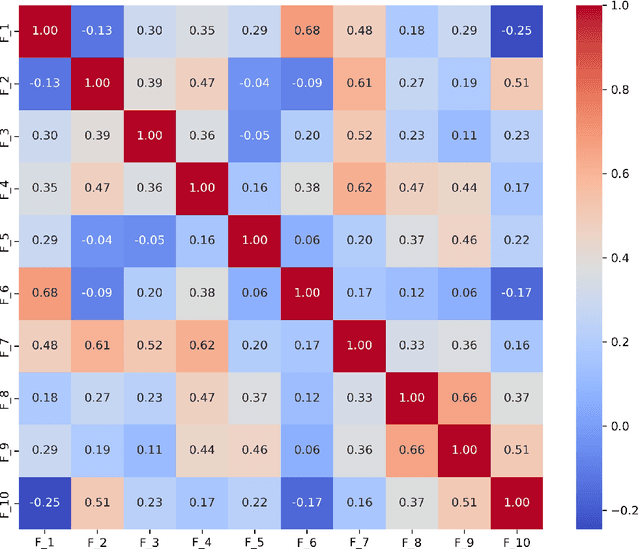
Abstract:Diagnosing language disorders associated with autism is a complex and nuanced challenge, often hindered by the subjective nature and variability of traditional assessment methods. Traditional diagnostic methods not only require intensive human effort but also often result in delayed interventions due to their lack of speed and specificity. In this study, we explored the application of ChatGPT, a state of the art large language model, to overcome these obstacles by enhancing diagnostic accuracy and profiling specific linguistic features indicative of autism. Leveraging ChatGPT advanced natural language processing capabilities, this research aims to streamline and refine the diagnostic process. Specifically, we compared ChatGPT's performance with that of conventional supervised learning models, including BERT, a model acclaimed for its effectiveness in various natural language processing tasks. We showed that ChatGPT substantially outperformed these models, achieving over 13% improvement in both accuracy and F1 score in a zero shot learning configuration. This marked enhancement highlights the model potential as a superior tool for neurological diagnostics. Additionally, we identified ten distinct features of autism associated language disorders that vary significantly across different experimental scenarios. These features, which included echolalia, pronoun reversal, and atypical language usage, were crucial for accurately diagnosing ASD and customizing treatment plans. Together, our findings advocate for adopting sophisticated AI tools like ChatGPT in clinical settings to assess and diagnose developmental disorders. Our approach not only promises greater diagnostic precision but also aligns with the goals of personalized medicine, potentially transforming the evaluation landscape for autism and similar neurological conditions.
UPDExplainer: an Interpretable Transformer-based Framework for Urban Physical Disorder Detection Using Street View Imagery
May 04, 2023Abstract:Urban Physical Disorder (UPD), such as old or abandoned buildings, broken sidewalks, litter, and graffiti, has a negative impact on residents' quality of life. They can also increase crime rates, cause social disorder, and pose a public health risk. Currently, there is a lack of efficient and reliable methods for detecting and understanding UPD. To bridge this gap, we propose UPDExplainer, an interpretable transformer-based framework for UPD detection. We first develop a UPD detection model based on the Swin Transformer architecture, which leverages readily accessible street view images to learn discriminative representations. In order to provide clear and comprehensible evidence and analysis, we subsequently introduce a UPD factor identification and ranking module that combines visual explanation maps with semantic segmentation maps. This novel integrated approach enables us to identify the exact objects within street view images that are responsible for physical disorders and gain insights into the underlying causes. Experimental results on the re-annotated Place Pulse 2.0 dataset demonstrate promising detection performance of the proposed method, with an accuracy of 79.9%. For a comprehensive evaluation of the method's ranking performance, we report the mean Average Precision (mAP), R-Precision (RPrec), and Normalized Discounted Cumulative Gain (NDCG), with success rates of 75.51%, 80.61%, and 82.58%, respectively. We also present a case study of detecting and ranking physical disorders in the southern region of downtown Los Angeles, California, to demonstrate the practicality and effectiveness of our framework.
Video-based Contrastive Learning on Decision Trees: from Action Recognition to Autism Diagnosis
Apr 21, 2023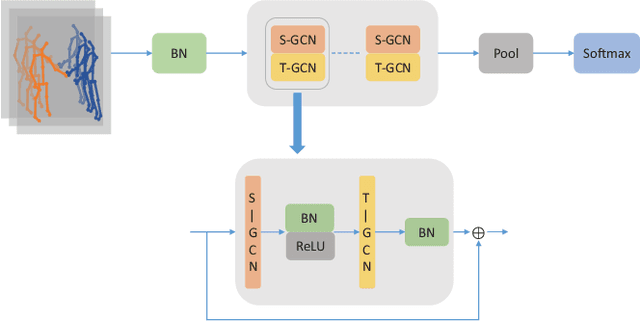
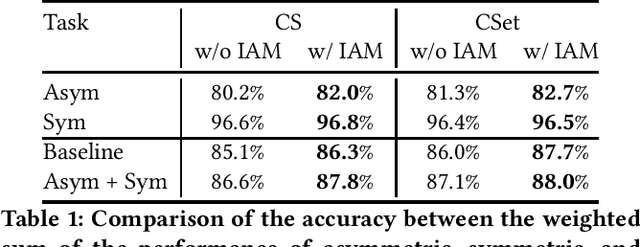

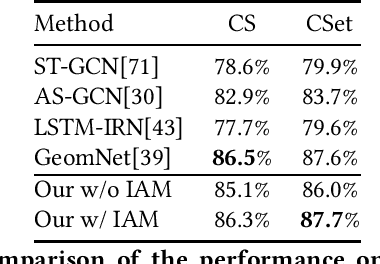
Abstract:How can we teach a computer to recognize 10,000 different actions? Deep learning has evolved from supervised and unsupervised to self-supervised approaches. In this paper, we present a new contrastive learning-based framework for decision tree-based classification of actions, including human-human interactions (HHI) and human-object interactions (HOI). The key idea is to translate the original multi-class action recognition into a series of binary classification tasks on a pre-constructed decision tree. Under the new framework of contrastive learning, we present the design of an interaction adjacent matrix (IAM) with skeleton graphs as the backbone for modeling various action-related attributes such as periodicity and symmetry. Through the construction of various pretext tasks, we obtain a series of binary classification nodes on the decision tree that can be combined to support higher-level recognition tasks. Experimental justification for the potential of our approach in real-world applications ranges from interaction recognition to symmetry detection. In particular, we have demonstrated the promising performance of video-based autism spectrum disorder (ASD) diagnosis on the CalTech interview video database.
 Add to Chrome
Add to Chrome Add to Firefox
Add to Firefox Add to Edge
Add to Edge